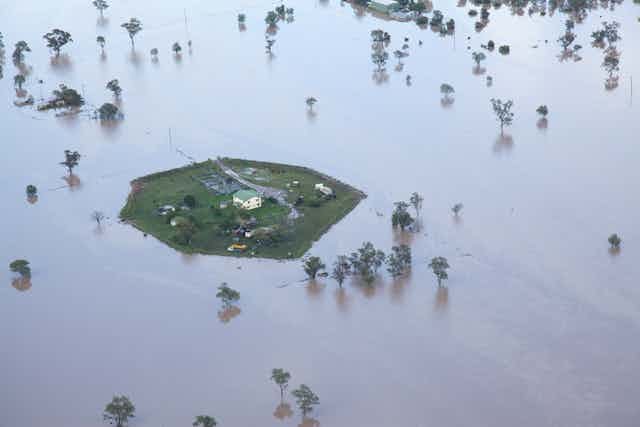The linear nature of global warming trends projected by the IPCC since 1990 and as late as 2007 (see Figure 1) has given the public and policy makers an impression there is plenty of time for economies to convert from carbon-emitting industries to non-polluting utilities.
Paleo-climate records suggest otherwise. They display abrupt shifts in the atmosphere/ocean/cryosphere system, as manifest in the ice core records of the last 800,000 years. This suggests high sensitivity of the climate system to moderate changes in radiative forcing, whether triggered by changes in solar radiation energy or the thermal properties of greenhouse gases or aerosols. In some instances these shifts have happened over periods as short as centuries to decades, and even over a few years.
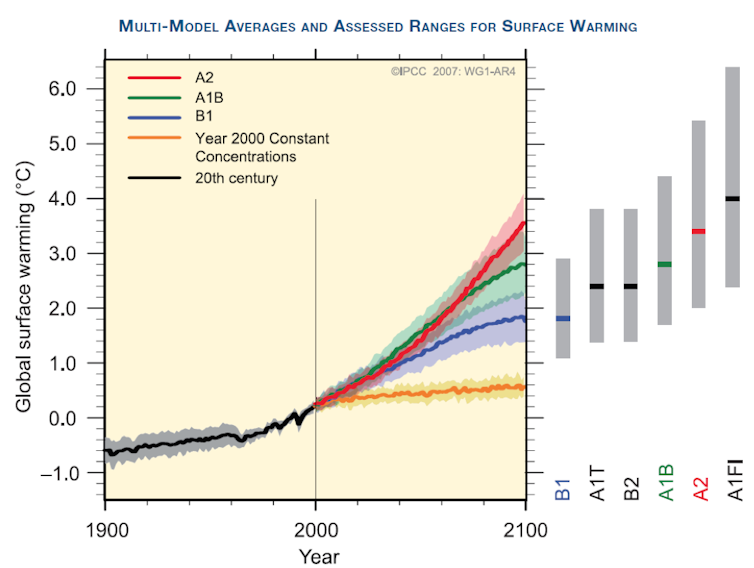
Examples of abrupt climate shifts are the 1470 years-long Dansgaard-Oeschger intra-glacial cycles, which were triggered by solar signals amplified by ocean currents, and the “younger dryas” cold interval, which occured when interglacial peaks resulted in extensive melting of ice and cooling of large ocean regions by melt water.
The last glacial termination (when large-scale melting of ice occurred between about 18,000 to 11,000 years ago) is attributed to transient solar pulsations of 40–60 Watt/m2 affecting mid-northern latitudes. This led to a ~6.5+/-1.5 Watt/m2 rise in mean global atmospheric energy level, which meant a mean global temperature rise of ~5.0+/-1.0 degrees Celsius and sea level rise of 120 meters (see Figure 2).
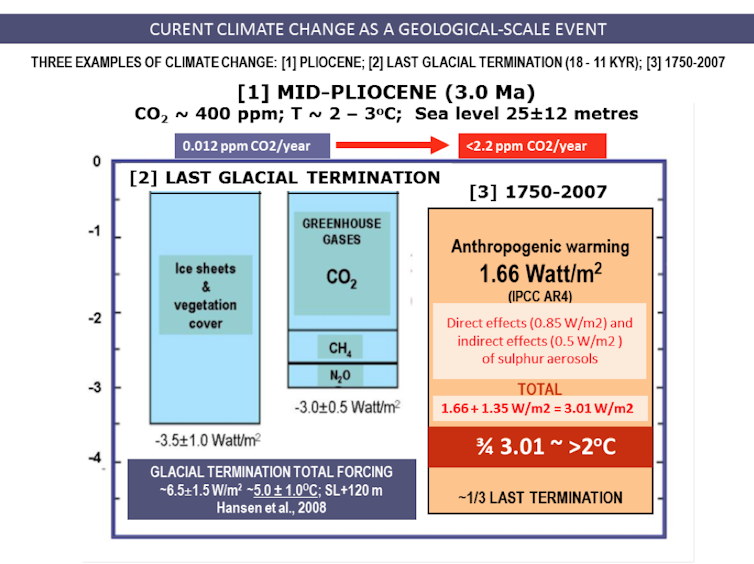
As shown in Figure 2, anthropogenic carbon emission and land clearing since 1750 have raised the atmospheric energy level by +1.66 Watt/m2. Once the masking effect of industrial sulphur aerosols is taken into account. This totals ~3.0 Watt/m2, namely near half the radiative forcing associated with the last glacial termination.
Compounding the major rise in radiative forcing over the last ~260 years is the rate of greenhouse gas (GHG) rise. This has averaged ~0.5ppm CO2 per year since 1750. That’s more than 40 times the rate during the last glacial termination, which was 0.012ppm CO2 per year. The current CO2 rise rate - 2ppm a year - is the fastest recorded for the Cainozoic (the period since 65 million years ago) (see Figure 3).
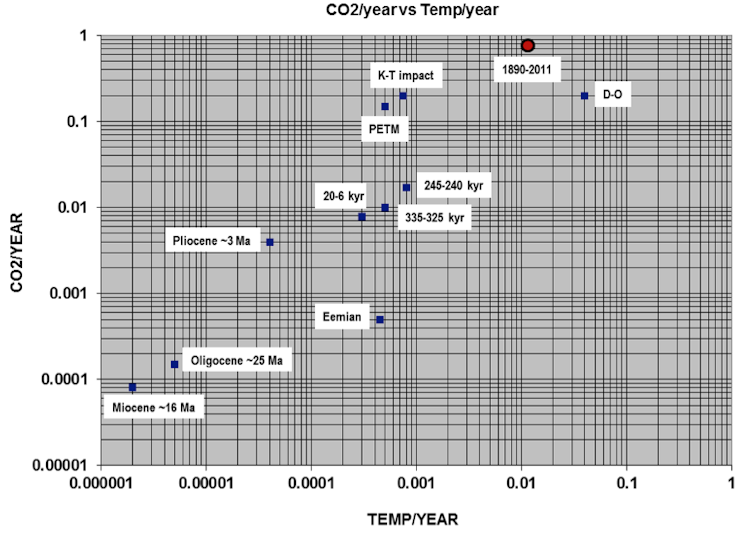
We have seen this scale and rate of radiative forcing, in particular since the 1970s, expressed by intensification of the hydrological cycle, heat waves and hurricanes around the globe. It imparts a new meaning to the otherwise little-defined term, “tipping point”.
Between 1900 and 2000, the ratio of observed to expected extremes in monthly mean temperatures has risen from ~1.0 to ~3.5. From about 1970 the Power Dissipation Index (which combines storm intensity, duration, and frequency) of North Atlantic storms increased from ~1.0 to ~2.7-5.5 in accord with tropical sea surface temperatures which rose by about 1.0 degree Celsius.
Coumou and Rahmstorf (of the Potsdam climate impacts research institutestate:
The ostensibly large number of recent extreme weather events has triggered intensive discussions, both in- and outside the scientific community, on whether they are related to global warming. Here, we review the evidence and argue that for some types of extreme — notably heat waves, but also precipitation extremes — there is now strong evidence linking specific events or an increase in their numbers to the human influence on climate. For other types of extreme, such as storms, the available evidence is less conclusive, but based on observed trends and basic physical concepts it is nevertheless plausible to expect an increase.
Hansen et al analysed the distribution of anomalous weather events relative to the 1951–1980 base line, displaying a shift toward extreme heat events (see Figure 4). The authors observe:
hot extreme[s], which covered much less than 1% of Earth’s surface during the base period (1951-1980), now typically [cover] about 10% of the land area. It follows that we can state, with a high degree of confidence, that extreme anomalies such as those in Texas and Oklahoma in 2011 and Moscow in 2010 were a consequence of global warming because their likelihood in the absence of global warming was exceedingly small.

The consequences for the biosphere of accelerating climate change are discussed by Baronsky et al in the following terms:
Localized ecological systems are known to shift abruptly and irreversibly from one state to another when they are forced across critical thresholds. Here we review evidence that the global ecosystem as a whole can react in the same way and is approaching a planetary-scale critical transition as a result of human influence.
Climates found at present on 10–48% of the planet are projected to disappear within a century, and climates that contemporary organisms have never experienced are likely to cover 12–39% of Earth. The mean global temperature by 2070 (or possibly a few decades earlier) will be higher than it has been since the human species evolved.
At 400ppm CO2, potential climate conditions have reached levels which last existed in the peak Pliocene epoch (5.3-2.6 million years ago). Given an increase in extreme weather events under conditions of +0.8C, an even higher rate of extreme events is expected under conditions of +2.0C currently shielded by industrially emitted sulphur aerosols.
Current trends in the frequency and intensity of extreme weather events are evident globally (see Figure 5). In the USA, the number of meteorological, hydrological and climatological events rose from about 20-40 per year during 1980-1988, to about 40-80 per year during 1989-2005, to between 70-100 per year after 2006, consistent with global rise in the frequency of extreme weather events.
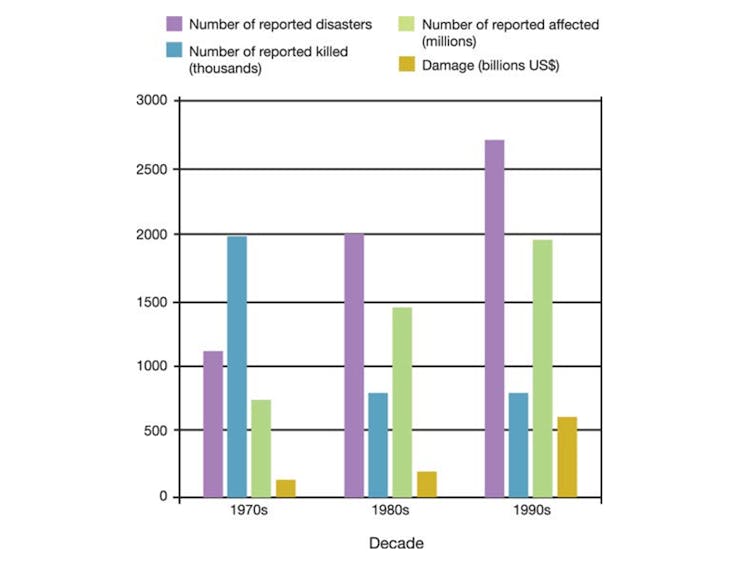
There is still time to act and avoid a worsening climate, but we are wasting precious time. We can solve the challenge of climate change with a gradually rising fee on carbon collected from fossil-fuel companies, with 100% of the money rebated to all legal residents on a per capita basis. This would stimulate innovations and create a robust clean-energy economy with millions of new jobs. It is a simple, honest and effective solution.
New solar technologies promise to provide a large part of the answer. Time is of the essence.

